Support Replacement AWD Vehicles
Special Tools
J 37043 Park Brake Cable Release Tool
Removal Procedure
- Place the park brake lever in the release position.
- Raise and support the vehicle. Refer to
Lifting and Jacking the Vehicle.
- Remove the tires and wheels. Refer to
Tire and Wheel Removal and Installation.
- Remove the exhaust muffler. Refer to
Muffler Replacement.
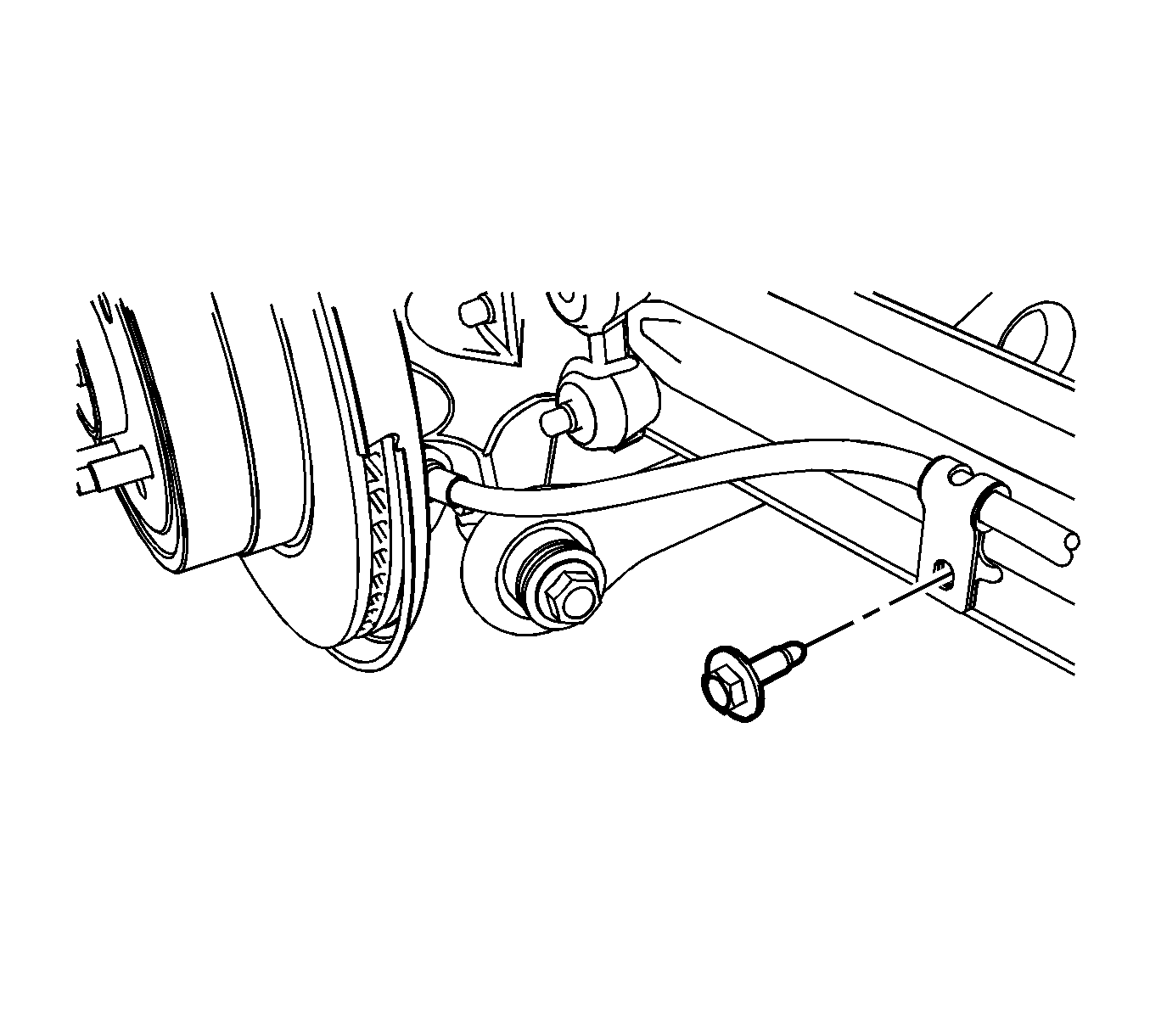
- Remove the rear park brake cable routing bolts from the trailing arms.
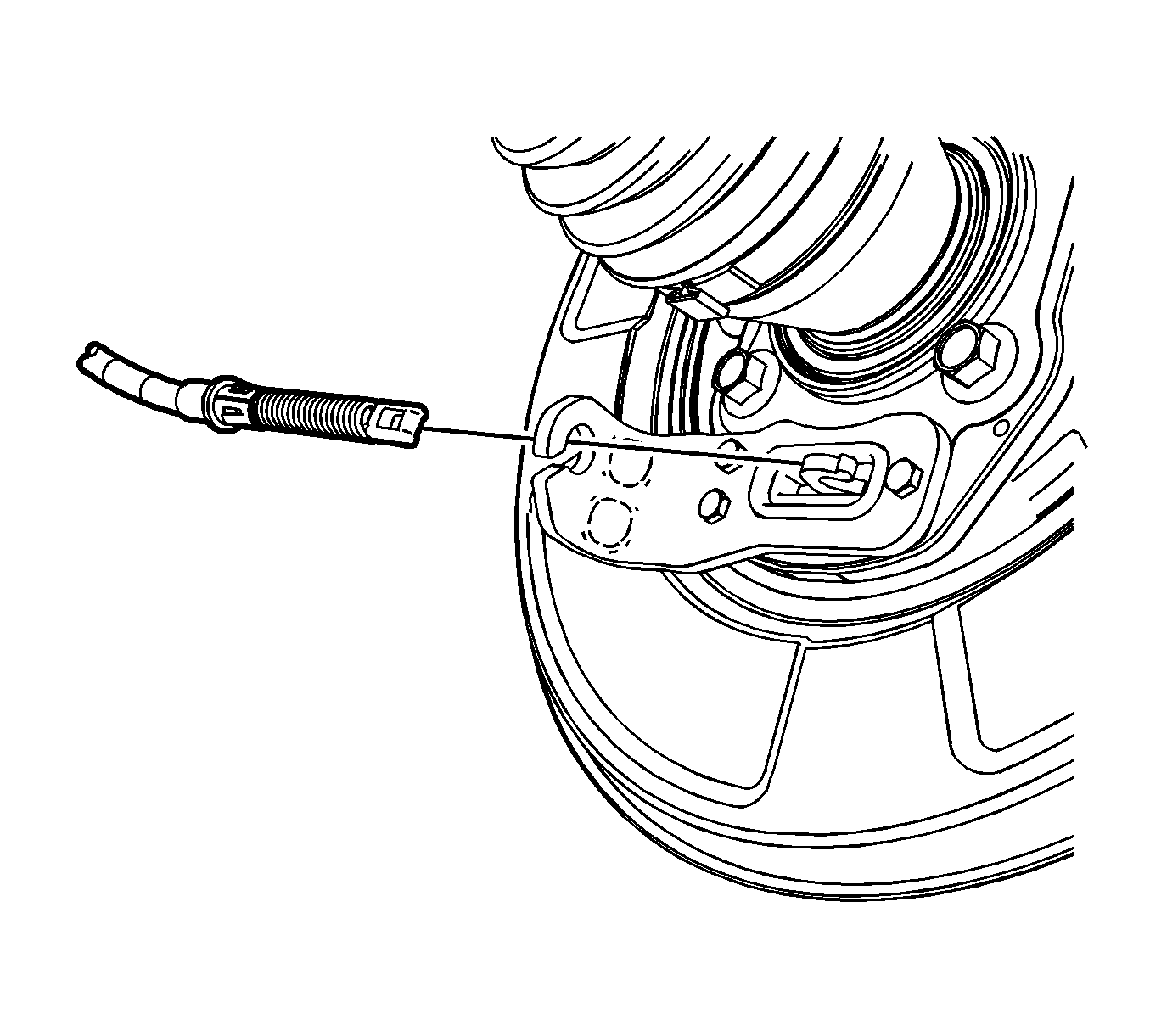
- Disconnect the rear park brake cables from the park brake actuators.
- Using the
J 37043 , remove the park brake cables from the mounting brackets
- Position the rear park brake cables aside.
- Disconnect the rear wheel speed sensor electrical connectors and routing clips from the rear support and upper control arms.
Position the wiring harness aside.
- Remove the rear brake hose bracket nut and bolt.
Caution: Support the brake caliper with heavy mechanic wire, or equivalent, whenever it is separated from its mount and the hydraulic flexible brake hose is still connected. Failure to support the caliper
in this manner will cause the flexible brake hose to bear the weight of the caliper, which may cause damage to the brake hose and in turn may cause a brake fluid leak.
- Remove the brake calipers and brackets as assemblies and support them with heavy mechanics wire or equivalent. Refer to
Rear Brake Caliper Bracket Replacement.

- While holding the stabilizer link with a wrench, remove the stabilizer link-to-lower control arm nut.
- Remove the trailing arms. Refer to
Trailing Arm Replacement.
- Remove the adjustment links. Refer to
Adjust Link Replacement.
- Remove the rear wheel drive shafts. Refer to
Rear Wheel Drive Shaft Replacement.
- Remove the rear differential. Refer to
Differential Replacement.
- Position a transmission jack under the rear support and firmly secure the support to the jack with straps.
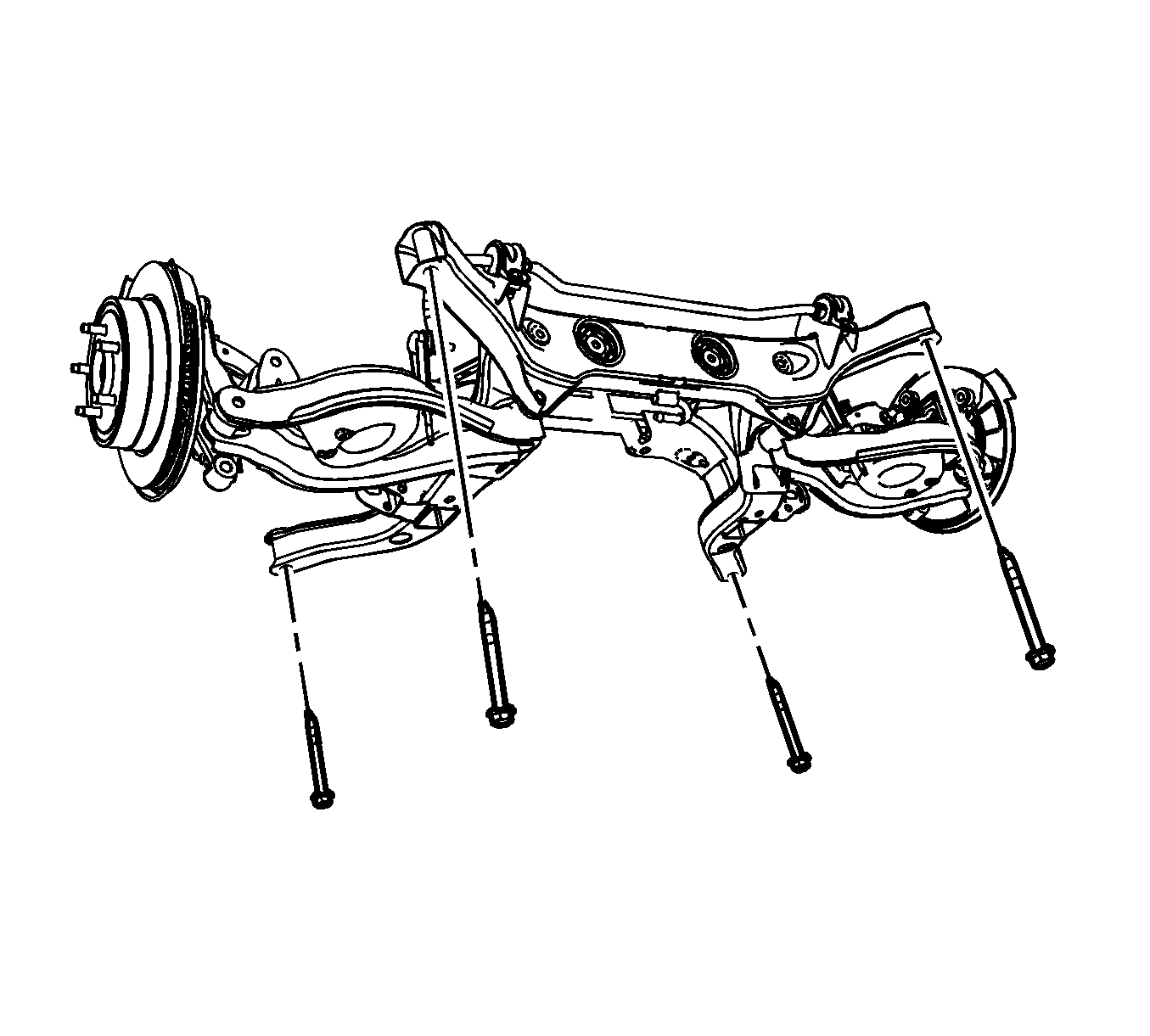
- Remove the 4 rear support to body bolts.
- Remove the rear support assembly from the vehicle.
- With the aid of an assistant, remove the rear support from the transmission jack and place it on the floor.
Installation Procedure
Caution: Refer to Fastener Caution in the Preface section.
- If a new rear support is being installed, a transfer of components is necessary.
| • | Tighten the upper control arm to rear support nut and bolt to
160 N·m (118 lb ft). |
| • | Tighten the lower control arm to rear support nut and bolt to
110 N·m (81 lb ft). |
| • | Stabilizer bar and insulators |
| - | Tighten the stabilizer shaft insulator clamp bolts to
70 N·m (52 lb ft). |
| - | Tighten the stabilizer link to stabilizer shaft nut to
50 N·m (37 lb ft). |
| • | Knuckles - Loosely install the upper and lower control arm to knuckle nuts/bolts. These fasteners will be tightened later in this procedure after the wheel driveshafts are installed. |
- With the aid of an assistant, position the rear support onto the transmission jack and firmly secure the support to the jack with straps.
- Position the rear support assembly to the vehicle.

- Install the 4 rear support to body bolts and tighten the bolts to
170 N·m (125 lb ft).
- Install the rear differential. Refer to
Differential Replacement.
- Install the rear wheel drive shafts. Refer to
Rear Wheel Drive Shaft Replacement.
- Install the adjustment links. Refer to
Adjust Link Replacement.
- Install the trailing arms. Refer to
Trailing Arm Replacement.

- While holding the stabilizer link, install the stabilizer link-to-lower control arm nut and tighten the stabilizer link to lower control arm nut to
15 N·m (11 lb ft).
Caution: Support the brake caliper with heavy mechanic wire, or equivalent, whenever it is separated from its mount and the hydraulic flexible brake hose is still connected. Failure to support the caliper
in this manner will cause the flexible brake hose to bear the weight of the caliper, which may cause damage to the brake hose and in turn may cause a brake fluid leak.
- Remove the supporting wire and position the brake caliper and bracket assemblies back onto the knuckles. Refer to
Rear Brake Caliper Bracket Replacement.
- Install the rear brake hose bracket nut and bolt and tighten the rear brake hose bolt and nut to
12 N·m (106 lb in).
- Position the wiring harness back to the original location, connect the routing clips to the rear support and upper control arms.
Connect the rear wheel speed sensor electrical connectors.

- Connect the rear park brake cables through the mounting brackets and onto the park brake actuators.

- Install the rear park brake cable routing bolts to the trailing arms and tighten the rear park brake cable routing bolt to
12 N·m (106 lb in).
- Install the exhaust muffler. Refer to
Muffler Replacement.
- Install the tires and wheels. Refer to
Tire and Wheel Removal and Installation.
- Check the rear alignment. Refer to
Wheel Alignment Measurement.
Support Replacement FWD Vehicles
Special Tools
J 37043 Park Brake Cable Release Tool
Removal Procedure
- Place the park brake lever in the release position.
- Raise and support the vehicle. Refer to
Lifting and Jacking the Vehicle.
- Remove the tires and wheels. Refer to
Tire and Wheel Removal and Installation.
- Remove the exhaust muffler. Refer to
Muffler Replacement.

- Remove the rear park brake cable routing bolts from the trailing arms.
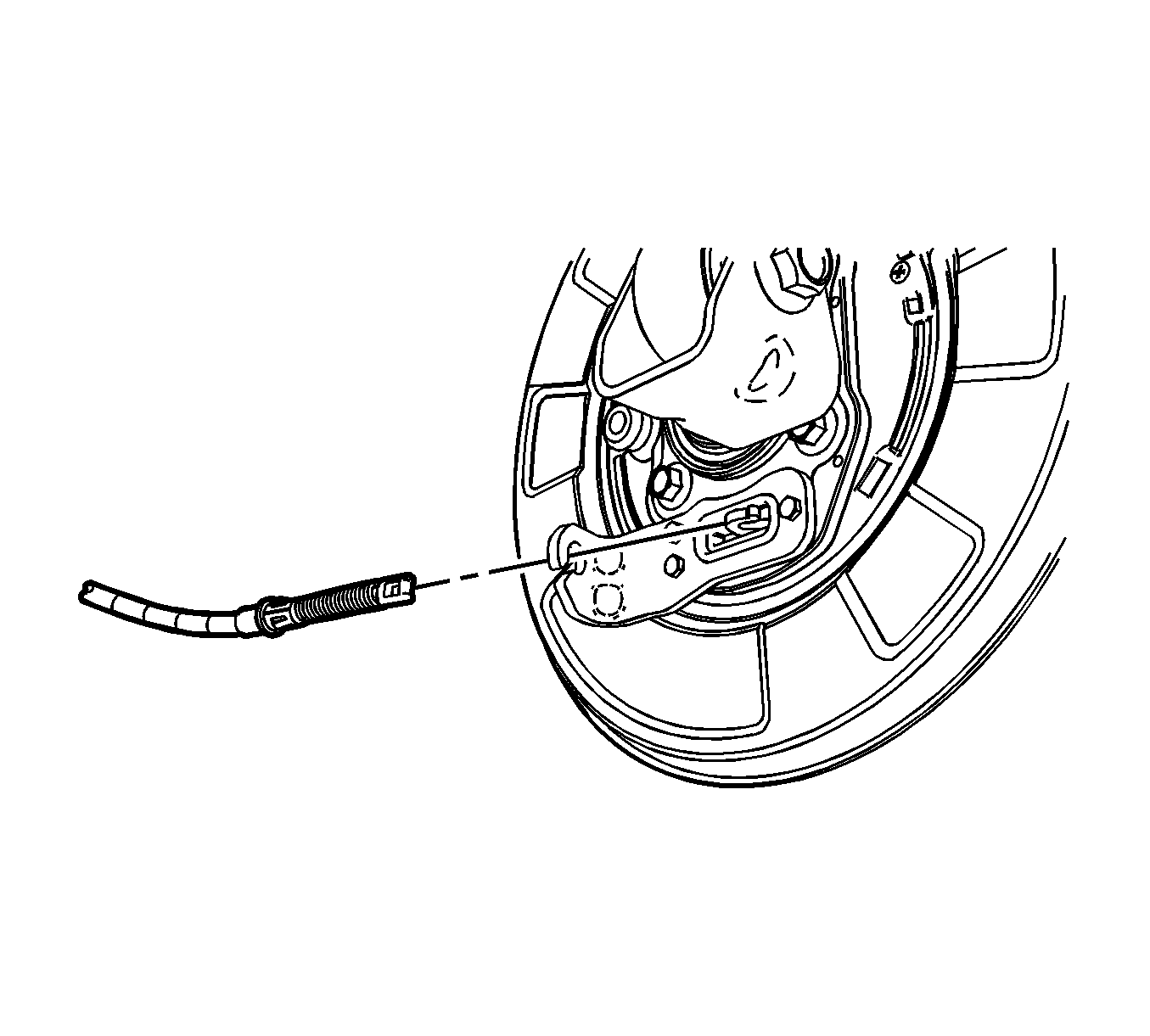
- Disconnect the rear park brake cables from the park brake actuators.
- Using the
J 37043 , remove the park brake cables from the mounting brackets
- Position the rear park brake cables aside.
- Disconnect the rear wheel speed sensor electrical connectors and the routing clips from the rear support and upper control arms.
Position the wiring harness aside.
- Remove the rear brake hose bracket nut and bolt.
Caution: Support the brake caliper with heavy mechanic wire, or equivalent, whenever it is separated from its mount and the hydraulic flexible brake hose is still connected. Failure to support the caliper
in this manner will cause the flexible brake hose to bear the weight of the caliper, which may cause damage to the brake hose and in turn may cause a brake fluid leak.
- Remove the brake calipers and brackets as assemblies and support them with heavy mechanics wire or equivalent. Refer to
Rear Brake Caliper Bracket Replacement.

- While holding the stabilizer link with a wrench, remove the stabilizer link-to-lower control arm nut.
- Remove the trailing arms. Refer to
Trailing Arm Replacement.
- Remove the adjustment links. Refer to
Adjust Link Replacement.
- Remove the coil springs. Refer to
Coil Spring Replacement.
- Position a transmission jack under the rear support and firmly secure the support to the jack with straps.
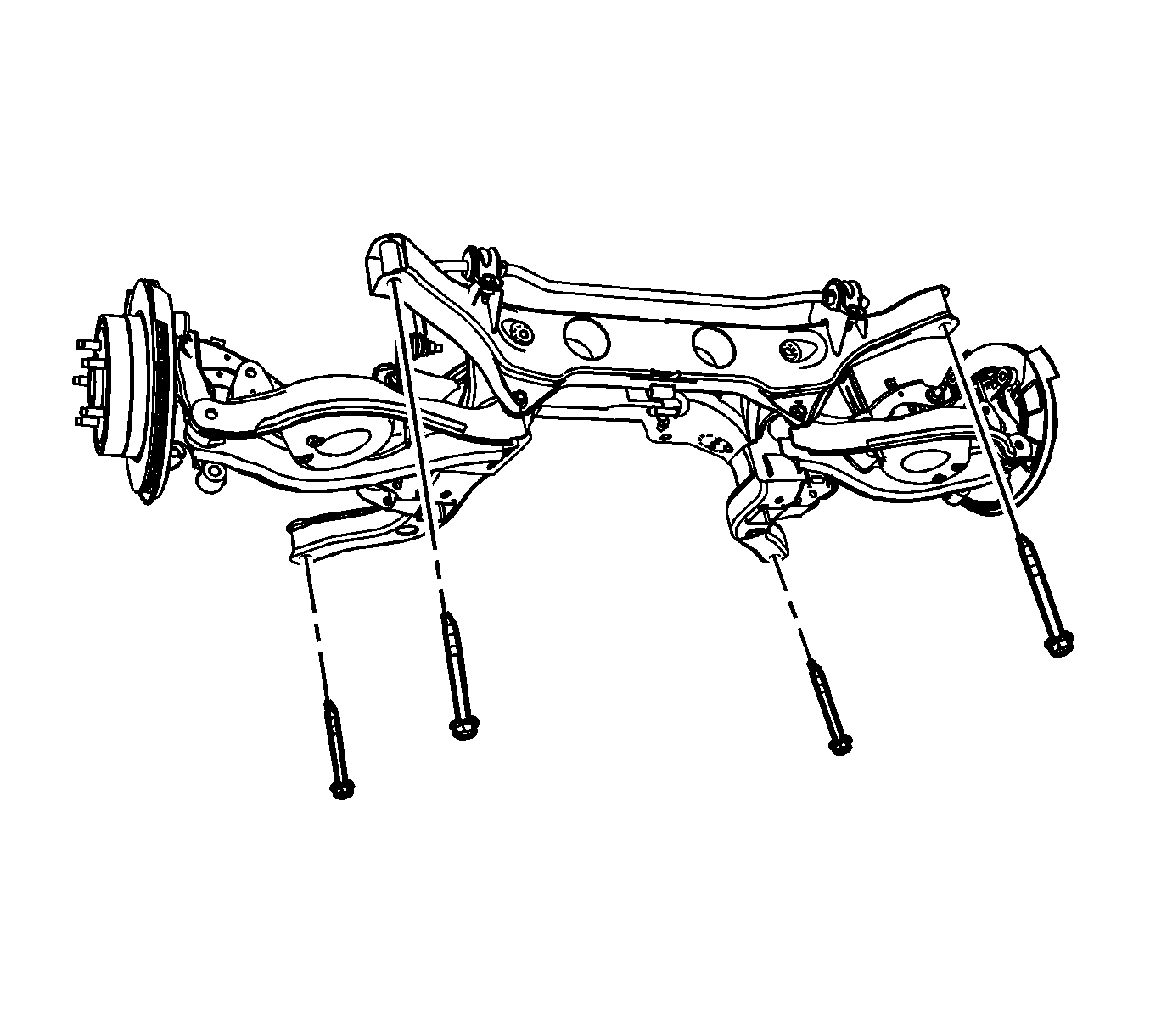
- Remove the 4 rear support to body bolts.
- Remove the rear support assembly from the vehicle.
- With the aid of an assistant, remove the rear support from the transmission jack and place it on the floor.
Installation Procedure
Caution: Refer to Fastener Caution in the Preface section.
- If a new rear support is being installed, a transfer of components is necessary.
| • | Tighten the upper control arm to rear support nut and bolt to
160 N·m (118 lb ft). |
| • | Tighten the lower control arm to rear support nut and bolt to
110 N·m (81 lb ft). |
| • | Stabilizer bar and insulators |
| - | Tighten the stabilizer shaft insulator clamp bolts to
70 N·m (52 lb ft). |
| - | Tighten the stabilizer link to stabilizer shaft nut to
57 N·m (42 lb ft). |
| • | Knuckles - The lower control arm to knuckle bolt/nut will be installed and tightened when the coil spring is installed later in this procedure. |
| • | Tighten upper control arm to knuckle bolt and nut to
160 N·m
(118 lb ft). |
- With the aid of an assistant, position the rear support onto the transmission jack and firmly secure the support to the jack with straps.
- Position the rear support assembly to the vehicle.

- Install the 4 rear support to body bolts and tighten the rear support to body bolts to
170 N·m (125 lb ft).
- Install the coil springs. Refer to
Coil Spring Replacement.
- Install the adjustment links. Refer to
Adjust Link Replacement.
- Install the trailing arms. Refer to
Trailing Arm Replacement.

- While holding the stabilizer link, install the stabilizer link-to-lower control arm nut and tighten the stabilizer link to lower control arm nut to
15 N·m (11 lb ft).
Caution: Support the brake caliper with heavy mechanic wire, or equivalent, whenever it is separated from its mount and the hydraulic flexible brake hose is still connected. Failure to support the caliper
in this manner will cause the flexible brake hose to bear the weight of the caliper, which may cause damage to the brake hose and in turn may cause a brake fluid leak.
- Remove the supporting wire and position the brake caliper and bracket assemblies back onto the knuckles. Refer to
Rear Brake Caliper Bracket Replacement.
- Install the rear brake hose bracket nut and bolt and tighten the rear brake hose bolt and nut to
12 N·m (106 lb in).
- Position the wiring harness back to the original location, connect the routing clips to the rear support and upper control arms. Connect the rear wheel speed sensor electrical connectors.

- Connect the rear park brake cables through the mounting brackets and onto the park brake actuators.

- Install the rear park brake cable routing bolts to the trailing arms and tighten the rear park brake cable routing bolt to
12 N·m (106 lb in).
- Install the exhaust muffler. Refer to
Muffler Replacement.
- Install the tires and wheels. Refer to
Tire and Wheel Removal and Installation.
- Check the rear alignment. Refer to
Wheel Alignment Measurement.
















